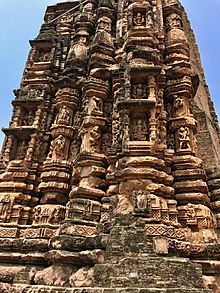Arang Jain Temples
History
Arang was ruled in ancient times by the Haihayas Rajput dynasty. Archaeological finds establishes that the town had an ancient history as the centre of Hindu and Jain religious faiths. Arang also finds mention in the Hindu epic Mahabharata.
Arang has many Jain and Hindu temples that date backs to the 9th to 11th centuries. Archaeological excavations carried out in the town has confirmed the town's ancient history as a Hindu and Jain religious centre, which prospered under the rule of Hindu kings.
The ancient temples in Arang, which are tourist attractions are the Baghdeval temple, the Bhanda Dewal temple, the Mahamaya temple, the Danteshwari temple, the Chandi Maheshwari temple, the Panchmukhi Mahadev temple, and the Panchmukhi Hanuman temple. Of these, the Bhand Dewal temple and Bagh Deval temple are particularly ancient and well-known. In May 2017 an idol of Adinath (Rishabhanatha) was excavated near this temple. This idol is 1.16 metres (3 ft 10 in) in height, 37 centimetres (15 in) in width and 21 centimetres (8.3 in) in thickness. This standing sculpture has a Yaksha and Yakshini near its knee region on two sides. The sculpture is dated to 5th-6th centuries AD.
Temples
Bhand Dewal temple

Bhand Dewal temple, a Jain temple dated to the late eleventh century, is in the Mahakosala area of Arang. The temple is built in Bhumija architecture. The plinth of this temple has detailed ornamentation. It has a socle that supports a pedestal and two rows of sculptures on the wall. The temple layout plan is in a star shape known as stellate (meaning: shaped like a star, having points, or rays radiating from a centre) with six "offsets". The temple rises to five floors, which is considered an unusual feature.
The temple faces west and is in a rundown condition. In the past, a mandapa (an outdoor pavilion) and a porch probably existed as part of the temple. The damaged front fascia of the temple tower has been plastered without any decoration and also whitewashed. The north-east and south-east faces of the temple tower, which were also dilapidated, have been redone in brick and mortar, but crudely. However, the overall view of the tower is still pleasing. At some stage, this temple was used as a survey marking station. As there was a tendency for the upper half of the tower to structurally burst by its seams, a metal strap bracing has been wound around the tower at the middle section to give it stability. A similar strap has been wound round at the top of the tower. A large number of images are carved on the exterior and interior faces of the temple. The bigger images are carved in two lines. Above the lines of bigger images, a row of carvings of smaller images has been sculpted. At the base of the larger images is a row of a highly decorated depiction of inscription panels, flowers, and a royal march of horses, animals, and people. The exterior faces of the temple have been embellished with carved images.
The temple has three free-standing large images of Jain tirthankaras deified in the garbha griha or sanctum sanctorum. These are carved ornately in black stone and highly polished. The three Tirthankaras are Ajitanatha, Neminath and Shreyanasanatha. The central figure is adorned with the symbol of a wheel holding two deer in the left hand, and a globe on the right hand. The base of this image has a "winged figure" carving. Carved images also embellish the exterior faces of the temple.
Bagh Deval temple
Bagh Deval temple, which was inferred initially as a Jain temple, is dated to the 11th century. It has similar architectural features as the Khajuraho temple.
Mahamaya temple
Mahamaya temple also has three colossal images of Tirthankaras. There is also a large single stone sculpture with illustrations of all 24 Tirthankaras carved on it.
Gallery
-
Bhand Dewal in 1873
-
Carvings on the wall, Bhand Deul
Current status
It is a protected monument under the Raipur circle of Archaeological Survey of India, since 1920.
See also
References
Citation
- ^ Garg 1992, p. 578.
- ^ Provinces 1909, p. 259.
- ^ Surjan & Verma 1996, p. 18.
- ^ Archaeological Survey of India 1878, p. 165.
- ^ "Ancient idol of Tirthankar Adinath found at Arang". The Hitavada. 19 May 2016. Archived from the original on 20 May 2016. Retrieved 30 June 2016.
- ^ Jain 1972, p. 446.
- ^ Archaeological Survey of India 1878, p. 160.
- ^ Archaeological Survey of India 1878, p. 161.
- ^ Archaeological Survey of India 1878, p. 162.
- ^ Shah 1987, p. 154.
- ^ Beglar 1878, p. 162.
- ^ "Centrally Protected Monuments/Sites/Remains, Archaeological Survey of India. Raipur Circle, Raipur" (PDF). ASI. Retrieved 10 February 2015.
- ^ ASI, Raipur Circle.
Sources
- Archaeological Survey of India (Reports 1862-1884 ed.), Archaeological Survey of India – Government Press, 1878, retrieved 2017-10-02
- Garg, Gaṅgā Rām (1992). Encyclopaedia of the Hindu World. Concept Publishing Company. ISBN 978-81-7022-376-4.
- Jain, Kailash Chand (1972). Malwa Through the Ages, from the Earliest Times to 1305 A.D. Motilal Banarsidass. ISBN 978-81-208-0824-9.
- Central Provinces (1909). Raipur district. Central Provinces District Gazetteers. Vol. 8 (1 ed.). Pioneer Press.
- Beglar, J. D. (1878), Report of a Tour in Bundelkhand and Malwa, 1871-72, And in the Central Provinces, 1873-74, vol. 7, Office of the Superintendent of Government Printing, retrieved 2017-10-04
- Shah, Umakant Premanand (1987), Jaina Iconography, vol. 1, Abhinav Publications, ISBN 9788170172086, retrieved 2017-10-04
- Alphabetical List of Monuments - Chhattisgarh, Archaeological Survey of India, archived from the original on 2017-10-10, retrieved 2017-10-07
- Surjan, Lalit; Verma, Vinod (1996). Reference Deśabandhu Madhya Pradesh. Deshbandhu Publication Division. ISBN 978-81-900733-1-8. Retrieved 28 February 2021.
External links
 Media related to Arang Jain temples at Wikimedia Commons
Media related to Arang Jain temples at Wikimedia Commons


